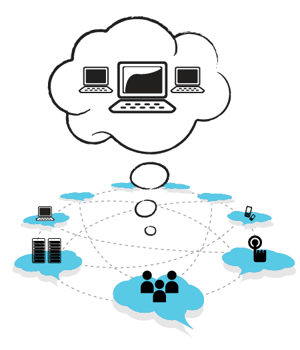 The world is undergoing a digital transformation, spurring a revolution of ideas and changing alterations that are rivaling that of the industrial revolution. It is producing a globally competitive environment of unrivaled proportions in which success is defined by the ability to garner the empowering assets of knowledge, innovation and IT agility to turn ideas into value at a breathtaking pace.
The world is undergoing a digital transformation, spurring a revolution of ideas and changing alterations that are rivaling that of the industrial revolution. It is producing a globally competitive environment of unrivaled proportions in which success is defined by the ability to garner the empowering assets of knowledge, innovation and IT agility to turn ideas into value at a breathtaking pace.
The cloud is about pooling computing, networking and storage resources and making them readily available to the applications and clouds that consume them. As a result, we create an environment of untold elasticity and flexibility. By utilizing the cloud, organizations can now create on-demand models relying on the agility and speed of virtualization, which enable companies such as Lyft and Airbnb to seemingly disrupt entire industries overnight. By leveraging the cloud and a cost structure in which organizations only pay for utilized resources—entrepreneurs, startups and the smallest of businesses now have access to IT infrastructure once reserved for only the largest of corporations. It is truly an exciting time to do business.
In order to competitively flourish in this age of digital transformation, you need to augment your on premise IT environment with the added advantages of the public cloud, forming a hybrid cloud model. In order to achieve this, you have to choose an appropriate Cloud Management Platform that fits the needs of your organization. This is a critical decision and one that should not be rushed as any public cloud vendor essentially becomes a business partner. Although the provisioning of applications, services and virtual machines can only take a matter of minutes, the configuration of your hybrid environment as well as the process of transferring data in and out of the cloud requires proper planning, resources and time. In order to help accentuate the decision process, we have singled out some of the leading CMP solutions available today. All of these solutions can help deliver value back to your organization, but it’s important to understand the playing field before selecting a solution.
AMAZON WEB SERVICES
Who would have guessed back in 2005 that what started as an ecommerce site specializing in books would become an IT giant? AWS is the big player on the block, having offered cloud computing services since 2006. In 2015 they surpassed 1 million active enterprise business customers. Its client list is a who’s who of enterprise organizations including IBM, Netflix, The CIA, Airbnb, Nike and Pfizer. They have over 100 data centers that make up 33 availability zones spread across 12 regions of the world. They have more than 6.4 million servers worldwide. Many of their data centers boast over 100Tbps of bandwidth. Until recently, AWS had more than 10 times the compute capacity of all of its 14 closest rivals combined. When one fully contemplates their reach and numbers across the world, it is understandable why they continue to dominate.
AWS is built around what it refers to as Elastic Compute Cloud or EC2, which utilizes Xen virtualization. A virtual machine is referred to as an instance or Amazon Machine Image (AMI). Users can choose from a variety of preconfigured templates for their instances and select their desired level of CPU, memory, storage and networking capacity. They offer nearly any server operating system you would need including CentOS, Red Hat Linux, Windows, Ubuntu and SUSE Linux. Their storage unit is referred to as Amazon Elastic Block Storage or EBS volume. You can manage your AWS environment using either the AWS Management Console, the AWS Command Line Tools (CLI) or AWS SDKs. Note that AWS charges for server time by the hour, not the minute.
MICROSOFT AZURE
Microsoft was a little late to the table in offering a viable cloud computing solution. However, Microsoft has succeeded once again to become a leader in this industry due to their ability to throw seemingly infinite resources towards catching up and propelling ahead of established competitors. Its Azure Cloud solution is the second largest provider in the world and is the only other solution to share Gartner’s Leader Magic Quadrant designation with AWS. It is currently twice the scale of its nearest rival with 100 Azure data centers in 24 regions. Each region is paired with another region for redundancy and no paired region is less than 300 miles away. It currently hosts over two million servers.
Besides being a household name for over three decades, Microsoft’s cloud solution is popular for businesses and organizations that are long time Windows oriented. Although Azure does support some versions of Linux, it is still predominantly Windows-centric. Many people have the misunderstanding that Azure Active Directory is simply the cloud version of Server Active Directory, but the two are nonequivalent products. Azure AD management is a flat structure rather than the hierarchical model that AD admins are accustomed to. Azure AD wasn’t created to replace Server AD but to augment it to support Internet resources. It will synchronize with on premise AD and allow password write back as well as Identity Management services. Its virtualization structure is made up of Hyper-V.
VCLOUD AIR
Although not near as big as the previous two players on the block, VMware is a very attractive solution for any organization that already implements some sort of vSphere solution. After all, VMware propelled virtualization into the limelight with their ESX product earlier this century. IT teams with an extensive knowledge base of vSphere or vCloud will find that vCloud Air is simply a natural extension into hybrid cloud computing, as Azure and AWS do not support VMware. Although vCloud Air cannot come close to matching the global expanse of its data locations that make up its public cloud presence, it is a powerful option that in several ways offers greater customization of resource allocation for its virtual offerings.
vCloud Air utilizes something called the vCloud Connector which greatly simplifies the migration of your existing applications, workloads and templates from your private cloud to one or more public cloud offerings. vCloud Air is also known for its Disaster Recovery as a Service (DRaaS) offering.
CISCO ONE ENTERPRISE
So why is a hardware company now in the cloud computing management business? Well for starters they are the 5th largest software company based on revenue and they are a leading force in the Software Defined Networking paradigm. Just as Cisco is known as the gold standard when it comes to routers and switches, Cisco doesn’t want to be the largest hybrid cloud provider, it just wants to be the one offering the highest quality solution. Unlike AWS and Azure, Cisco relies on its network of partners for its data centers. Cisco also puts a great emphasis on security, making it an ideal partner for financial, medical and healthcare organizations. Like the AWS Marketplace, Cisco’s Prime Service Catalog makes it easy to order and configure complete infrastructure containers from the catalog, thus increasing time to innovation and value.
HPE HELION
Like Cisco, HPE is a long time hardware innovator and leader that is blazing its own trail in the world of software defined networking and cloud computing. Like Cisco, their model isn’t about creating a data center empire to take over the world on the scale of AWS, as it also relies on a partner based model. In fact, HPE’s solution is fully AWS compatible. In other words, HPE isn’t a public cloud provider, they are a provider of cloud management tools for both private and hybrid cloud models. HPE bases their cloud solution around OpenStack, thus eliminating the possibility of vendor lock-in for customers down the road. As companies are considering open source SDN solutions, their commitment to nonproprietary solutions such as OpenStack is setting them up well for the future as the worlds of cloud computing and the software defined data center unite.
TAKING A CLOSER LOOK
This review of cloud management platforms only scratches the surface. When it comes to actually building out your hybrid cloud solution, it will be critical to successfully navigate through potential challenges during planning, design, and implementation. The best approach is to consult with your IT solutions provider to learn about the opportunities and potential downfalls of all of these solutions. Your IT environment is unique and some solutions will be a better fit than others. A hybrid cloud will help your business scale and prepare for the future. The right IT partner for hybrid cloud implementation will be sure to consider your IT roadmap and business goals—preparing your company for immediate success and a scalable architecture to meet future demands.
About WEI
WEI is an innovative, full service, customer-centric IT solutions provider.
Why WEI? We go further.
At WEI, we’re passionate about solving your technology problems and helping you drive your desired business outcomes. We believe in challenging the status quo and thinking differently. There are a lot of companies that can take today’s technology and create a great IT solution for you. But we do more. We go further. And we have the customer, vendor and industry awards to prove it. WEI is a premier technology partner, who always puts our customers first while providing the most innovative solutions for over 30 years.


